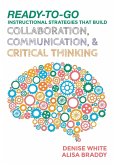- Broschiertes Buch
- Merkliste
- Auf die Merkliste
- Bewerten Bewerten
- Teilen
- Produkt teilen
- Produkterinnerung
- Produkterinnerung
A straightforward, easy-to-use resource on the core principles of critical thinking in intelligence analysis.
Andere Kunden interessierten sich auch für
![Critical Thinking in Health and Social Care Critical Thinking in Health and Social Care]() Stella Jones-DevittCritical Thinking in Health and Social Care67,99 €
Stella Jones-DevittCritical Thinking in Health and Social Care67,99 €![Leading Intelligence Analysis Leading Intelligence Analysis]() Bruce E. PeaseLeading Intelligence Analysis77,99 €
Bruce E. PeaseLeading Intelligence Analysis77,99 €![Ready-to-Go Instructional Strategies That Build Collaboration, Communication, and Critical Thinking Ready-to-Go Instructional Strategies That Build Collaboration, Communication, and Critical Thinking]() Denise M. WhiteReady-to-Go Instructional Strategies That Build Collaboration, Communication, and Critical Thinking34,99 €
Denise M. WhiteReady-to-Go Instructional Strategies That Build Collaboration, Communication, and Critical Thinking34,99 €![The Art of Impossible The Art of Impossible]() Steven KotlerThe Art of Impossible14,99 €
Steven KotlerThe Art of Impossible14,99 €![The True Believer The True Believer]() Eric HofferThe True Believer17,99 €
Eric HofferThe True Believer17,99 €![The Miniature Guide to Critical Thinking Concepts and Tools The Miniature Guide to Critical Thinking Concepts and Tools]() Richard PaulThe Miniature Guide to Critical Thinking Concepts and Tools16,99 €
Richard PaulThe Miniature Guide to Critical Thinking Concepts and Tools16,99 €![Critical Thinking Critical Thinking]() Richard L EpsteinCritical Thinking60,99 €
Richard L EpsteinCritical Thinking60,99 €-
-
-
A straightforward, easy-to-use resource on the core principles of critical thinking in intelligence analysis.
Hinweis: Dieser Artikel kann nur an eine deutsche Lieferadresse ausgeliefert werden.
Hinweis: Dieser Artikel kann nur an eine deutsche Lieferadresse ausgeliefert werden.
Produktdetails
- Produktdetails
- Verlag: SAGE Publications Inc
- 3 Revised edition
- Seitenzahl: 468
- Erscheinungstermin: 3. September 2020
- Englisch
- Abmessung: 229mm x 152mm x 26mm
- Gewicht: 662g
- ISBN-13: 9781544374260
- ISBN-10: 1544374267
- Artikelnr.: 59644807
- Herstellerkennzeichnung
- Books on Demand GmbH
- In de Tarpen 42
- 22848 Norderstedt
- info@bod.de
- 040 53433511
- Verlag: SAGE Publications Inc
- 3 Revised edition
- Seitenzahl: 468
- Erscheinungstermin: 3. September 2020
- Englisch
- Abmessung: 229mm x 152mm x 26mm
- Gewicht: 662g
- ISBN-13: 9781544374260
- ISBN-10: 1544374267
- Artikelnr.: 59644807
- Herstellerkennzeichnung
- Books on Demand GmbH
- In de Tarpen 42
- 22848 Norderstedt
- info@bod.de
- 040 53433511
Katherine Hibbs Pherson, President of Globalytica, LLC, consults with government and private industry on building strong analytic communities, the use of structured analytic techniques, and security issues. She teaches certificate courses on structured thinking and presentation for the security association ASIS International and in the Intelligence Masters program at Universidad Rey Juan Carlos in Madrid, Spain. As Vice Chair of the Intelligence and National Security Association (INSA)'s Security Policy Reform Council, she was primary drafter of its white paper titled "Next Steps for Security Reform: Industry Proposals to Enhance Efficiency and Reduce Costs in National Security Contracts," which has generated a series of productive exchanges among government and industry. Ms. Pherson is also Chief Executive Officer of Pherson Associates, LLC, and a founding Director of the Forum Foundation for Analytic Excellence, a nonprofit established in 2011 to promote the effective use of critical thinking skills and structured analytic techniques by teaching, certifying, and applying these skills in universities in the United States and Europe. She retired from the Central Intelligence Agency in 2000 after a twenty-seven-year career in intelligence and security analysis and resource management. Her leadership in the security arena led to the adoption of a risk management methodology, the strengthening of overseas security countermeasures, and improvements in dealing with unsolicited contacts. As head of the Director of Central Intelligence's Center for Security Evaluation, she managed the Intelligence Community's involvement in rebuilding the penetrated US Embassy in Moscow. She is a recipient of the CIA's Distinguished Career Intelligence Medal and the Intelligence Community's National Distinguished Service Medal. She received her AB from Vassar College, an MA in Spanish linguistics and Latin American studies from the University of Illinois, and an MA in
The Critical Thinker's Checklist
List of Figures
Foreword
Preface
About the Authors
Introduction to the Third Edition
Introduction
Part I: How Do I Get Started?
Chapter 1: Who Are Your Clients?
Chapter 2: What Are the Key Questions?
Chapter 3: What Is the Broader Context for the Analysis?
Chapter 4: How Should I Conceptualize My Product?
Chapter 5: What Is My Analytic Approach?
Chapter 6: Can Collaboration Contribute to a Better Answer?
Part II: Where Is The Information I Need?
Chapter 7: How Do Models Help My Analysis?
Chapter 8: What Types of Information Are Available?
Chapter 9: Can I Trust the Sources?
Chapter 10: How Should I Assess the Reliability of Internet Information?
Part III: What Is My Argument?
Chapter 11: Are My Key Assumptions Well-Founded?
Chapter 12: Can I Make My Case?
Chapter 13: Did I Consider Alternative Hypotheses?
Chapter 14: How Do I Deal With Politicization?
Chapter 15: How Might I Be Spectacularly Wrong?
Part IV: How Do I Convey My Message Effectively?
Chapter 16: Is My Argument Persuasive?
Chapter 17: How Should I Portray Probability, Levels of Confidence, and
Quantitative Data?
Chapter 18: How Can Graphics Support My Analysis?
Chapter 19: How Do I Present My Message in the Most Compelling Way?
Chapter 20: How Do I Know When I Am Finished?
Part V: Case Studies
Case Study I: Uncharted Territory
Case Study II: Russian Disinformation
Case Study III: Blackout on the Eastern Seaboard!
Case Study IV: The End of the Era of Aircraft Carriers
Case Study V: Puzzling Food Poisonings in Germany
Case Study VI: The Case of Iraq's Aluminum Tubes
Glossary of Terms
List of Names
Recommended Readings
US Government Publications
Index
The Analyst's Roadmap
List of Figures
Foreword
Preface
About the Authors
Introduction to the Third Edition
Introduction
Part I: How Do I Get Started?
Chapter 1: Who Are Your Clients?
Chapter 2: What Are the Key Questions?
Chapter 3: What Is the Broader Context for the Analysis?
Chapter 4: How Should I Conceptualize My Product?
Chapter 5: What Is My Analytic Approach?
Chapter 6: Can Collaboration Contribute to a Better Answer?
Part II: Where Is The Information I Need?
Chapter 7: How Do Models Help My Analysis?
Chapter 8: What Types of Information Are Available?
Chapter 9: Can I Trust the Sources?
Chapter 10: How Should I Assess the Reliability of Internet Information?
Part III: What Is My Argument?
Chapter 11: Are My Key Assumptions Well-Founded?
Chapter 12: Can I Make My Case?
Chapter 13: Did I Consider Alternative Hypotheses?
Chapter 14: How Do I Deal With Politicization?
Chapter 15: How Might I Be Spectacularly Wrong?
Part IV: How Do I Convey My Message Effectively?
Chapter 16: Is My Argument Persuasive?
Chapter 17: How Should I Portray Probability, Levels of Confidence, and
Quantitative Data?
Chapter 18: How Can Graphics Support My Analysis?
Chapter 19: How Do I Present My Message in the Most Compelling Way?
Chapter 20: How Do I Know When I Am Finished?
Part V: Case Studies
Case Study I: Uncharted Territory
Case Study II: Russian Disinformation
Case Study III: Blackout on the Eastern Seaboard!
Case Study IV: The End of the Era of Aircraft Carriers
Case Study V: Puzzling Food Poisonings in Germany
Case Study VI: The Case of Iraq's Aluminum Tubes
Glossary of Terms
List of Names
Recommended Readings
US Government Publications
Index
The Analyst's Roadmap
The Critical Thinker's Checklist
List of Figures
Foreword
Preface
About the Authors
Introduction to the Third Edition
Introduction
Part I: How Do I Get Started?
Chapter 1: Who Are Your Clients?
Chapter 2: What Are the Key Questions?
Chapter 3: What Is the Broader Context for the Analysis?
Chapter 4: How Should I Conceptualize My Product?
Chapter 5: What Is My Analytic Approach?
Chapter 6: Can Collaboration Contribute to a Better Answer?
Part II: Where Is The Information I Need?
Chapter 7: How Do Models Help My Analysis?
Chapter 8: What Types of Information Are Available?
Chapter 9: Can I Trust the Sources?
Chapter 10: How Should I Assess the Reliability of Internet Information?
Part III: What Is My Argument?
Chapter 11: Are My Key Assumptions Well-Founded?
Chapter 12: Can I Make My Case?
Chapter 13: Did I Consider Alternative Hypotheses?
Chapter 14: How Do I Deal With Politicization?
Chapter 15: How Might I Be Spectacularly Wrong?
Part IV: How Do I Convey My Message Effectively?
Chapter 16: Is My Argument Persuasive?
Chapter 17: How Should I Portray Probability, Levels of Confidence, and
Quantitative Data?
Chapter 18: How Can Graphics Support My Analysis?
Chapter 19: How Do I Present My Message in the Most Compelling Way?
Chapter 20: How Do I Know When I Am Finished?
Part V: Case Studies
Case Study I: Uncharted Territory
Case Study II: Russian Disinformation
Case Study III: Blackout on the Eastern Seaboard!
Case Study IV: The End of the Era of Aircraft Carriers
Case Study V: Puzzling Food Poisonings in Germany
Case Study VI: The Case of Iraq's Aluminum Tubes
Glossary of Terms
List of Names
Recommended Readings
US Government Publications
Index
The Analyst's Roadmap
List of Figures
Foreword
Preface
About the Authors
Introduction to the Third Edition
Introduction
Part I: How Do I Get Started?
Chapter 1: Who Are Your Clients?
Chapter 2: What Are the Key Questions?
Chapter 3: What Is the Broader Context for the Analysis?
Chapter 4: How Should I Conceptualize My Product?
Chapter 5: What Is My Analytic Approach?
Chapter 6: Can Collaboration Contribute to a Better Answer?
Part II: Where Is The Information I Need?
Chapter 7: How Do Models Help My Analysis?
Chapter 8: What Types of Information Are Available?
Chapter 9: Can I Trust the Sources?
Chapter 10: How Should I Assess the Reliability of Internet Information?
Part III: What Is My Argument?
Chapter 11: Are My Key Assumptions Well-Founded?
Chapter 12: Can I Make My Case?
Chapter 13: Did I Consider Alternative Hypotheses?
Chapter 14: How Do I Deal With Politicization?
Chapter 15: How Might I Be Spectacularly Wrong?
Part IV: How Do I Convey My Message Effectively?
Chapter 16: Is My Argument Persuasive?
Chapter 17: How Should I Portray Probability, Levels of Confidence, and
Quantitative Data?
Chapter 18: How Can Graphics Support My Analysis?
Chapter 19: How Do I Present My Message in the Most Compelling Way?
Chapter 20: How Do I Know When I Am Finished?
Part V: Case Studies
Case Study I: Uncharted Territory
Case Study II: Russian Disinformation
Case Study III: Blackout on the Eastern Seaboard!
Case Study IV: The End of the Era of Aircraft Carriers
Case Study V: Puzzling Food Poisonings in Germany
Case Study VI: The Case of Iraq's Aluminum Tubes
Glossary of Terms
List of Names
Recommended Readings
US Government Publications
Index
The Analyst's Roadmap








